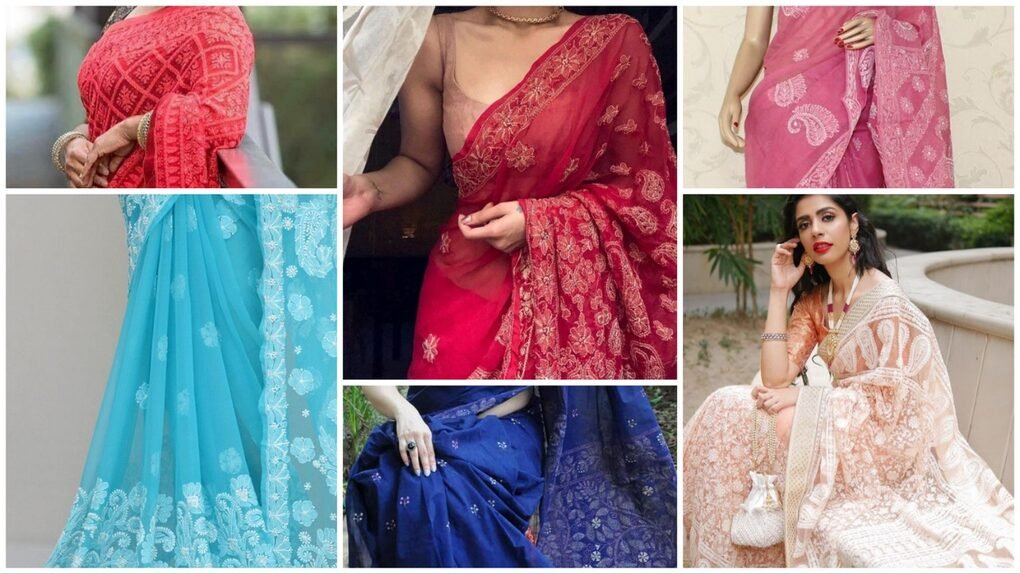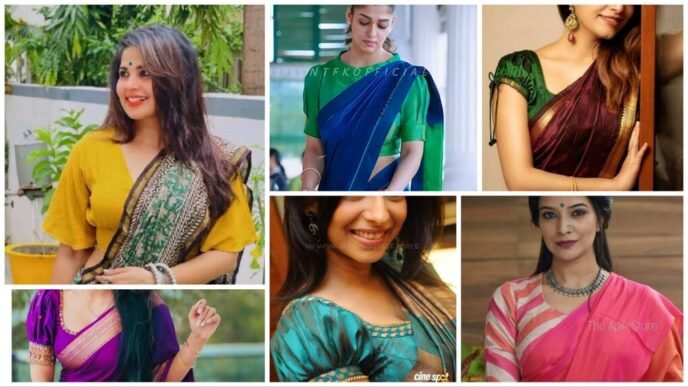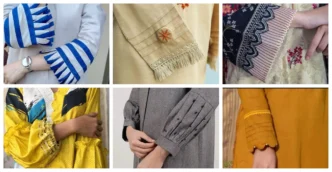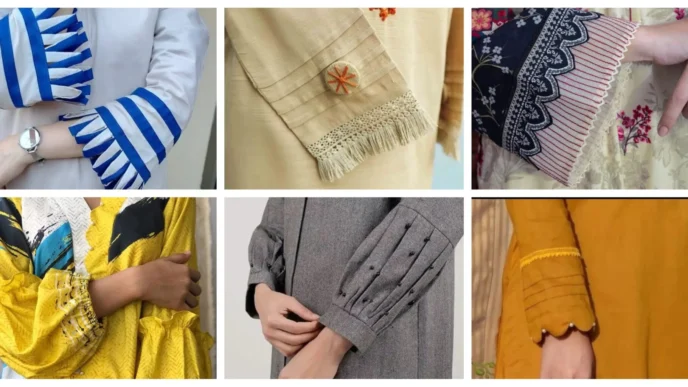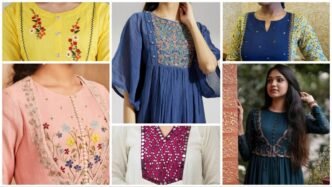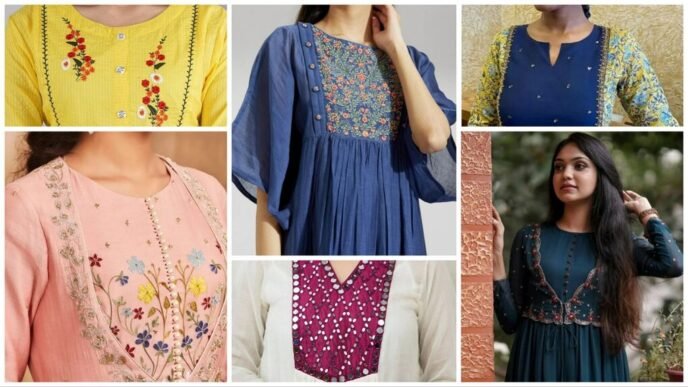Are you in search of a saree that beautifully blends tradition and elegance? Look no further, because we have a stunning collection of linen sarees, chanderi sarees, bandhani sarees, and handloom sarees. Introducing the exquisite artistry of Chanderi and handloom sarees, a traditional Lucknowi craft renowned for its intricate embroidery and bandhani techniques. These sarees showcase the beauty of double ikat weaving. Originating from the city of Lucknow, India, these handloom sarees are adorned with delicate threadwork that showcases the mastery of skilled weavers. The chanderi and bandhani designs make these sarees truly unique.
Picture yourself draped in a Chikankari saree, each stitch telling a story of heritage and craftsmanship. Add the elegance of linen sarees, the grace of chanderi, the vibrant colors of bandhani, and the artistry of handloom weaving to your wardrobe. These chanderi sarees are meticulously created using handloom techniques, resulting in stunning bandhani patterns and intricate designs that add a touch of timeless charm to your ensemble. Whether it’s for a special occasion or simply to make a style statement, Chikankari sarees made from chanderi and bandhani, two high-quality fabrics woven on handloom, effortlessly elevate your look.
Intrigued? In the following sections, we will delve deeper into the history, process, and significance of Chikankari sarees. These sarees are made by skilled weavers using the chanderi fabric and feature intricate patterns known as bandhani. Get ready to discover the captivating world of bandhani, an age-old art form known for its intricate designs and use of vibrant fabrics. This art form continues to enchant fashion enthusiasts around the globe, thanks to the skilled weavers who bring these beautiful creations to life.
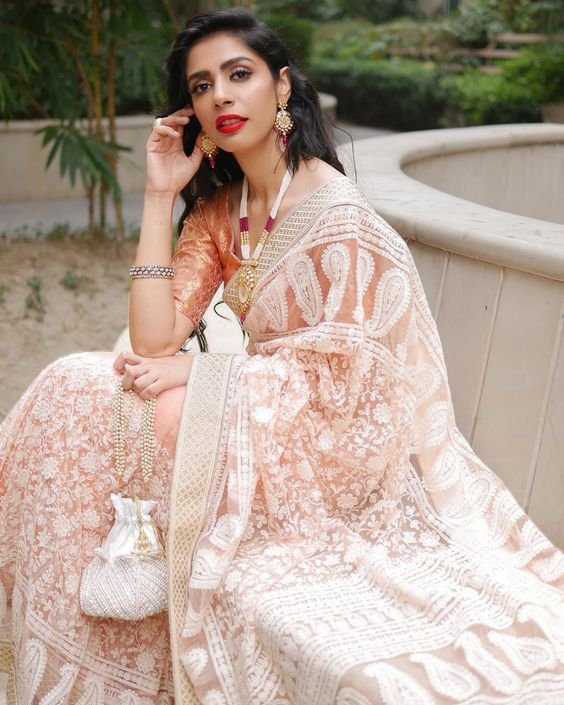

Significance and Historical Background of Chikankari Sarees
Chikankari sarees, known for their intricate embroidery, have a rich history that dates back to the Mughal era. These sarees are often made using chanderi and silk fabrics, and are adorned with beautiful bandhani patterns. These exquisite linen sarees and perfect chanderi sarees have been adorned by women for centuries, symbolizing elegance, grace, and cultural heritage. The intricate designs on these clothing pieces make them truly unique.
Rich History Dating Back to the Mughal Era
Chikankari embroidery, a traditional art form originating in Lucknow during the 17th century under Emperor Jahangir’s reign, is perfect for enhancing the beauty of bandhani, chanderi sarees, linen sarees, and dupattas. This intricate art form of bandhani was introduced by Nur Jehan, the wife of Emperor Jahangir, who had a deep passion for fine craftsmanship. She popularized the use of bandhani in chanderi sarees, linen sarees, and silk. The word “chikan” means embroidery in Persian, reflecting its Persian and Mughal influences. Chanderi sarees, silk bandhani, and intricate designs are all part of this rich tradition.
During this time, chikankari sarees, adorned with intricate designs and made from silk fabrics, became popular among the royal courtiers and nobility. These sarees were often paired with dupattas to complete the elegant look. The intricate designs and delicate handcrafted embroidery on these silk sarees showcased impeccable craftsmanship and attention to detail. These sarees are made with the finest fabrics and are perfect for pairing with beautiful dupattas. It soon became a status symbol among the elite class in the Luxurion world, with its high-quality dupattas and linen sarees.
Royal Patronage Contributed to Its Popularity
The popularity of chikankari sarees, known for their intricate designs and made with cotton fabrics, grew exponentially due to royal patronage. The addition of dupattas further enhanced their appeal. The Nawabs of Awadh were particularly fond of this art form and encouraged its development, especially when it came to dupattas, linen sarees, and cotton fabrics. They provided employment opportunities to skilled artisans and even set up workshops dedicated to chikankari embroidery, using fabrics such as cotton and creating beautiful designs on dupattas.
Under their patronage, chikankari, a traditional embroidery technique on cotton and linen fabrics, flourished as an integral part of Lucknow’s cultural identity, with its intricate designs becoming highly sought after. The art form of designs evolved over time with new motifs and techniques being incorporated into its repertoire. Fabrics like linen and cotton were used in creating these designs.
Symbolizes Elegance, Grace, and Cultural Heritage
Chikankari sarees, made from fabrics like linen and cotton, are renowned for their sheer beauty and elegance in designs. Each saree is meticulously hand-embroidered using white thread on fine fabrics such as linen, cotton, and silk. The designs are carefully crafted to showcase the beauty of these fabrics. The intricate patterns in these fabrics depict floral motifs, paisleys, vines, birds, and geometrical designs. Cotton fabrics are used to create these beautiful art forms that are admired around the world.
Wearing a chikankari saree made from cotton fabrics not only showcases one’s aesthetic sense but also represents a connection to the rich cultural heritage of Lucknow, where this art form is known for its intricate designs. It is a testament to the skill and craftsmanship of the artisans who have preserved this art form for generations in the world of fabrics and designs.
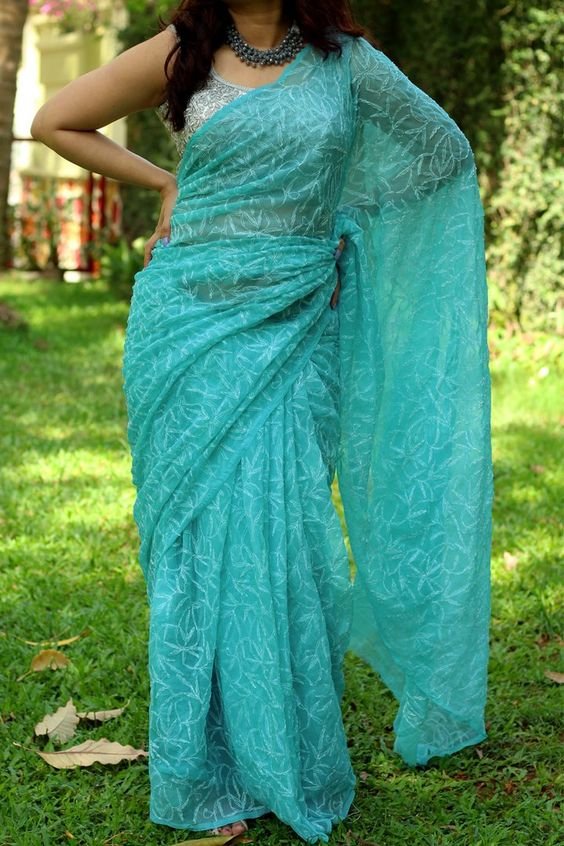

The Making of Chikankari Sarees</h “Making of Chikankari Sarees
The creation of chikankari sarees involves a meticulous process that requires skilled artisans and craftsmen. Each saree is carefully designed and hand-embroidered using white thread, enhancing the beauty of the fabric. Here’s an overview of the process:
Selection of Fine Fabrics
The choice of fabric is crucial to the making of chikankari sarees. Linen sarees, cotton, and silk fabrics are often used due to their ability to showcase intricate designs and patterns. The selection of the finest fabrics is the first step in creating these exquisite sarees. The fabric is then cut into the desired saree length and width.
Designing and Pattern Transfer
The design for the saree is first drawn on paper and then transferred onto the fabric. This step requires precision and attention to detail, as the design serves as the foundation for the embroidery work. Once the design is transferred, it’s time to start the intricate embroidery process.
Intricate Hand Embroidery
The heart of chikankari sarees lies in the intricate hand embroidery. Artisans use a fine needle and white thread to create delicate and intricate patterns on the fabric. Common motifs include flowers, leaves, vines, birds, and geometrical designs. The threadwork is so fine that it blends seamlessly with the fabric, creating a beautiful contrast.
Washing and Finishing
Once the embroidery is completed, the saree undergoes a washing process to remove any markings or stains. It is then carefully finished, which involves ironing and folding, resulting in a beautifully crafted chikankari saree ready to be worn.
Variations and Styles
Chikankari sarees come in various styles and designs, ranging from traditional to contemporary. Each region in India has its unique take on chikankari, and the style of embroidery can vary. Some sarees feature all-over chikankari embroidery, while others have motifs scattered across the fabric. The choice of fabric, threadwork, and design motifs can also differ, offering a wide variety of options for saree enthusiasts.
These variations make ch are renowned for their sheer beauty and elegance in designs. Each saree is meticulously hand-embroidered using white thread on fine fabrics such as linen, cotton, and silk. The designs are carefully crafted to showcase the beauty of these fabrics. The intricate patterns in these fabrics depict floral motifs, paisleys, vines, birds, and geometrical designs. Cotton fabrics are used to create these beautiful art forms that are admired around the world.
Wearing a chikankari saree made from cotton fabrics not only showcases one’s aesthetic sense but also represents a connection to the rich cultural heritage of Lucknow, where this art form is known for its intricate designs. It is a testament to the skill and craftsmanship of the artisans who have preserved this art form for generations in the world of fabrics and designs.


The Making of Chikankari Sarees
The creation of chikankari sarees involves a meticulous process that requires skilled artisans and craftsmen. Each saree is carefully designed and hand-embroidered using white thread, enhancing the beauty of the fabric. Here’s an overview of the process:
Selection of Fine Fabrics
The choice of fabric is crucial to the making of chikankari sarees. Linen sarees, cotton, and silk fabrics are often used due to their ability to showcase intricate designs and patterns. The selection of the finest fabrics is the first step in creating these exquisite sarees. The fabric is then cut into the desired saree length and width.
Designing and Pattern Transfer
The design for the saree is first drawn on paper and then transferred onto the fabric. This step requires precision and attention to detail, as the design serves as the foundation for the embroidery work. Once the design is transferred, it’s time to start the intricate embroidery process.
Intricate Hand Embroidery
The heart of chikankari sarees lies in the intricate hand embroidery. Artisans use a fine needle and white thread to create delicate and intricate patterns on the fabric. Common motifs include flowers, leaves, vines, birds, and geometrical designs. The threadwork is so fine that it blends seamlessly with the fabric, creating a beautiful contrast.
Washing and Finishing
Once the embroidery is completed, the saree undergoes a washing process to remove any markings or stains. It is then carefully finished, which involves ironing and folding, resulting in a beautifully crafted chikankari saree ready to be worn.
Variations and Styles
Chikankari sarees come in various styles and designs, ranging from traditional to contemporary. Each region in India has its unique take on chikankari, and the style of embroidery can vary. Some sarees feature all-over chikankari embroidery, while others have motifs scattered across the fabric. The choice of fabric, threadwork, and design motifs can also differ, offering a wide variety of options for saree enthusiasts.
These variations make chikankari sarees versatile, suitable for various occasions, from casual wear to formal events. The choice of colors and designs allows individuals to express their personal style while celebrating the rich tradition of chikankari sarees.
Whether you prefer the classic elegance of white-on-white chikankari or the vibrancy of colorful chikankari sarees, these garments are a testament to the timeless artistry of Indian artisans. So, the next time you drape yourself in a chikankari saree, you’re not just wearing a piece of clothing; you’re donning a work of art and a symbol of India’s rich cultural heritage.
In conclusion, chikankari sarees are more than just pieces of clothing; they are works of art that showcase the rich cultural heritage and craftsmanship of India. Whether you’re wearing one for a special occasion or incorporating it into your daily attire, chikankari sarees have a timeless appeal that never goes out of style. So, explore the world of chikankari sarees, and you’ll discover a treasure trove of beauty, tradition, and elegance.

Wearing a chikankari saree made from cotton fabrics not only showcases one’s aesthetic sense but also represents a connection to the rich cultural heritage of Lucknow, where this art form is known for its intricate designs. It is a testament to the skill and craftsmanship of the artisans who have preserved this art form for generations in the world of fabrics and designs.
In conclusion, chikankari sarees are more than just pieces of clothing; they are works of art that showcase the rich cultural heritage and craftsmanship of India. Whether you’re wearing one for a special occasion or incorporating it into your daily attire, chikankari sarees have a timeless appeal that never goes out of style. So, explore the world of chikankari sarees, and you’ll discover a treasure trove of beauty, tradition, and elegance.

Wearing a chikankari saree made from cotton fabrics not only showcases one’s aesthetic sense but also represents a connection to the rich cultural heritage of Lucknow, where this art form is known for its intricate designs. It is a testament to the skill and craftsmanship of the artisans who have preserved this art form for generations in the world of fabrics and designs.
In conclusion, chikankari sarees are more than just pieces of clothing; they are works of art that showcase the rich cultural heritage and craftsmanship of India. Whether you’re wearing one for a special occasion or incorporating it into your daily attire, chikankari sarees have a timeless appeal that never goes out of style. So, explore the world of chikankari sarees, and you’ll discover a treasure trove of beauty, tradition, and elegance.
I hope this information helps you complete your essay on chikankari sarees. If you have any more questions or need further assistance, please feel free to ask.
